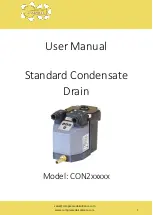
v1.0
www.compressedairalliance.com
4
Standard Condensate Drain
User Manual v1
About Condensate Drains
Introduction
Anyone that owns and operates a compressed
air system knows they generate vast amounts
of condensate. Managing this moisture load is
critical to the long term reliability and operation
of the entire system and all the related
equipment. Failure to do so results in
downstream moisture events that can
contaminate products, cause significant
damage and creates long term reliability issues
through corrosion and contamination.
Why install a condensate drain?
Contaminants can enter a compressed air
system at the compressor intake or be
introduced into the airstream by the system
itself. Lubricant, metal particles, rust, and pipe
scale are all separated and filtered
out, but it’s
the drains that have to operate properly for the
filters and separators to be successful in
completing their task.
Condensate drains are possibly the least
glamorous and most ignored component of a
compressed air system but nevertheless, a
most important part. No matter how much
money you spend on that fancy new
compressed air system, not spending a little
effort with your drain choice could cause you
no end of headaches and increased operating
costs for years to come.
Condensate Drain Types
Drains come in many types and variants from
no drain (yes, that is a drain choice), to
manually operated, timed and Zero Loss/Level
Sensor drains.
It is common to see timed drains used to
remove condensate at critical points on the
supply side of the system. As these operate on
a set timer, they are adjusted for the worst case
scenario and never looked at again, unless
there is a moisture event downstream. Valuable
compressed air is dumped every time these
types of drains operate resulting in increased
operating costs and losses in system efficiency.
Zero loss drains are far more effective at
removing condensate from compressed air
systems while maintaining system efficiency.
The level sensing ability of these drains means
they automatically adjust to the amount of
condensate being generated at any point in
time. The alarm functionality alerts the
appropriate personnel to a potential failure
before the system becomes overwhelmed with
condensate.
Where to install a condensate
drain?
The most critical areas requiring a condensate
drain are:
•
Compressors
–
Depending on the model,
your compressor can have anywhere from
zero to four condensate drains.
•
Refrigerant Dryers
–
These are often the
most neglected of drains, a typical
refrigerant dryer will have up to three
condensate drains.
•
Receivers
–
One of the most important
locations is the wet receiver. Most receivers
only have a single condensate drain, its
failure can cause catastrophic downstream
issues.
•
Filters - Like receivers, filters only have a
single condensate drain. Flooding a wet
side filter will cause premature failure. Most
dry side filters have a very small if any liquid
loading capability so its important to keep
them dry.
•
Drip Legs
–
These are often the last line of
defence before condensate reaches your
equipment. As these are only operated
when there has been a failure upstream,
they are often neglected until it is too late.



















